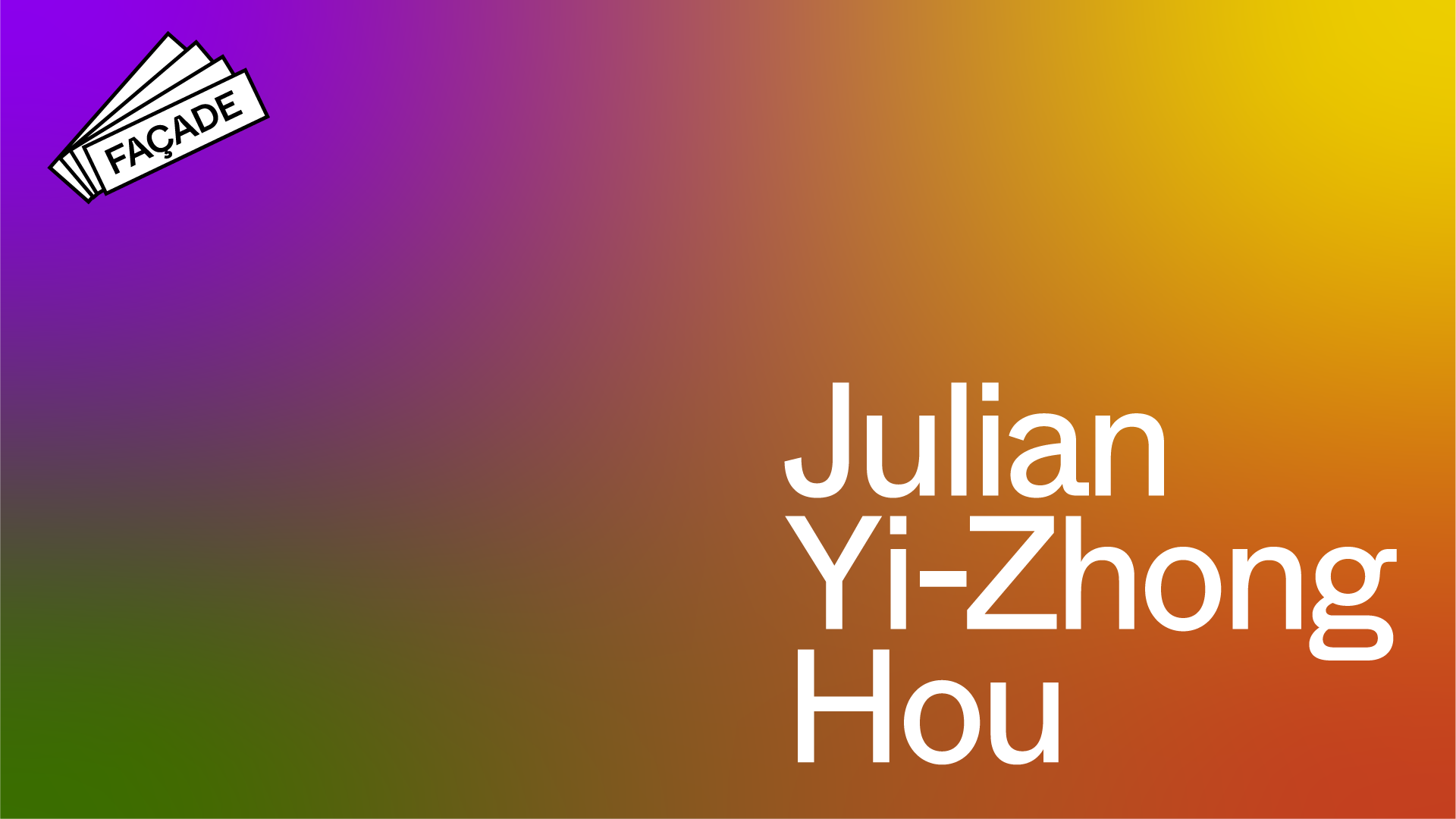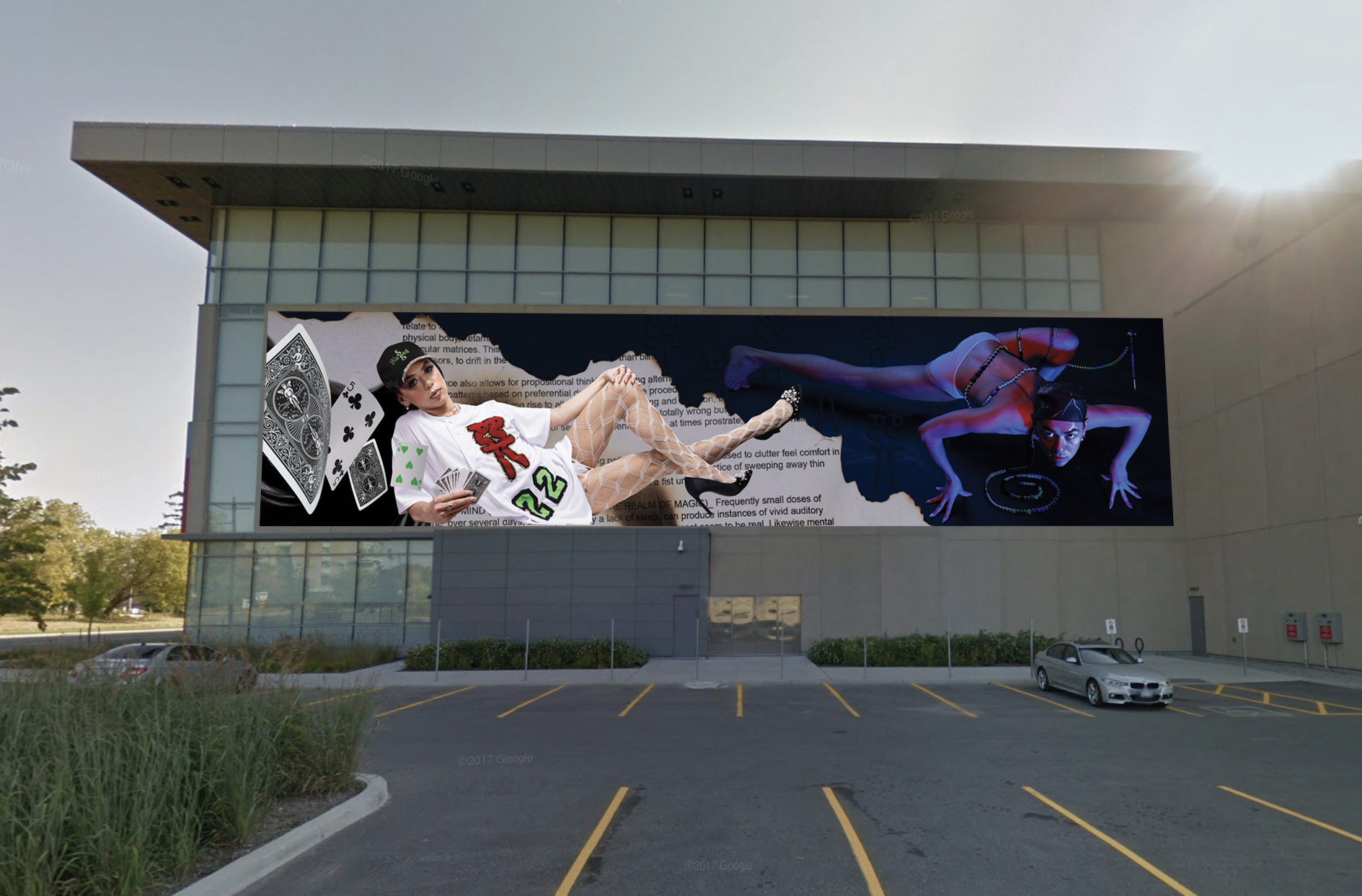

Bicycle by Julian Yi-Zhong Hou, a newly commissioned photo mural inaugurating the "Façade" series, unfolds like a wheel of the Chinese Yin Yang symbol in motion on the west side of Markham Pan Am Centre. The work deftly weaves thematic elements of gender identity, the queer gaze, Chinese and Western divination, popular fashion, architecture, and healing into a captivating tapestry.
The image portrayed in Hou’s Bicycle dazzles with layers of symbolism. Integrated into the west face of the Pan Am Centre, it evokes the highly ornamented facades of prominent civic and religious architecture from the ancient world onwards and across numerous cultures. Its many symbolic elements appear in constant transformation, flowing through a boundless process of encounter, association, and inversion. Bicycle’s intricate layers challenge conventional notions of duality, especially in the realm of gender politics, portraying them instead as opposing yet complementary forces in the universe. The work urges us to rethink and embrace the complexities of gender and identity.
The Yin Yang symbol (太极图) embodies the concept of duality and harmony in Chinese philosophy, featuring a circle divided into black (Yin 阴) and white (Yang 阳) halves with a dot of each colour within the opposite side, suggesting that Yin and Yang are not fixed entities but rather dynamic and ever-transforming energies—Yin can transition into Yang and vice versa, each containing the seed of the other within itself. Bicycle breathes life into Yin Yang with a dual portrait of queer artist James Albers and their drag persona, Lady Boi Bangkok, posing in the style of glossy fashion photos. Lady Boi Bangkok's attire, a baseball jersey-like "boyfriend (out)fit," or what she calls "double drag," symbolizes the seed of Yang within Yin, highlighting the contrast between the two forces. On the other hand, Albers, free of costume, performs as themselves, embodying a genderfluid figure hidden in the dark with an intense gaze, creating an image of unification.
The head accessory on each of Albers’ characters further reinforces concepts of duality and harmony. Lady Boi Bangkok, posing in spotlight, wears a black baseball cap with the text "bleSSed," a variation derived from the Chinese character Xun (巽) printed on her jersey. On the Yang side, Albers, residing in the dark, dons a headscarf with a winter night-time camouflage print. Written here in ancient seal script (篆书), the Chinese character Xun (巽) finds its roots in I-Ching, an ancient divination text representing "Wind over Wind." Through connections and inversions, it transforms into "SS," referring to "Second Spring," one of Hou’s projects that involves the theme of rebirth. The character's snake-like shape hints at the caduceus, a symbol of health, while the text "bleSSed" on the cap reinforces the theme with a tone of irony.
The number 22, another inversion of “SS,” corresponds to Hou's personal numerology 4 and serves as another personal anecdote planted in the work. It further appears as 5 + 5 on Lady Boi Bangkok's playing cards. Clubs represents the Second Spring organization, while Hearts, in green, signifies heart transformation, healing, and new growth. The title Bicycle is derived from the brand of playing cards and the symmetrical image of Cupid riding a bicycle—a wheel within a wheel, adding another layer of symbolism to the piece.
The broken necklace on Albers evokes the Rod of Asclepius, symbolizing healing and freedom while stylistically nodding to the ancient imperial Chinese necklace. In addition to a reference of the Yin Yang symbol, Hou's mapping of the image divides it into the realms of the conscious (left) and unconscious (right). It serves as a double portrait, depicting both the characters and the artist himself, reflecting a conscious reality of performed gender and a relatively gender-fluid unconscious.
Riding on the interplay of personal and universal, duality and harmony, Yin and Yang, Julian Yi-Zhong Hou’s Bicycle challenges gender norms and explores the depths of identity. Through symbolism and layered imagery, Hou invites viewers to contemplate the harmonious dance of dualities and embrace the complexities of the self.
Text by Yan Wu
Julian Yi-Zhong Hou is a multidisciplinary artist that currently resides in British Columbia, Canada. His work centres around contemporary mystical themes including consciousness, divination, and symbology. Recent works have been shown on e-flux; San Antonio Artpace; Music Gallery, Toronto; Zalucky Contemporary, Toronto; Contemporary Art Gallery, Vancouver; Artspeak, Vancouver; SFU Audain gallery, Vancouver; and the Vancouver Art Gallery. He recently completed Crossroads (2021), a large-scale stained glass public artwork in Burnaby, B.C.
The artist would like to acknowledge the following individuals for their contribution to the work:
Producer: Austin Taylor
Photographer: Ole Vezina
Model: James Albers
Production Support: Amy Gottung
Consultant: Tiziana La Melia